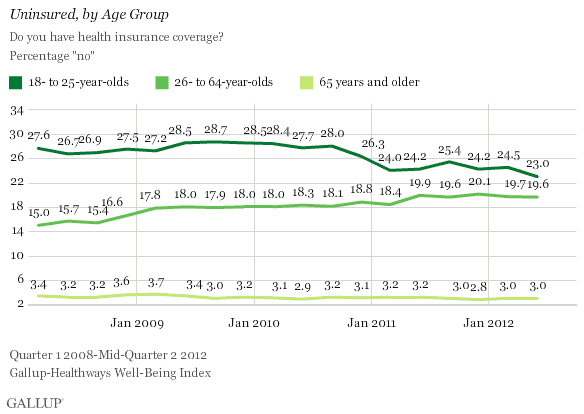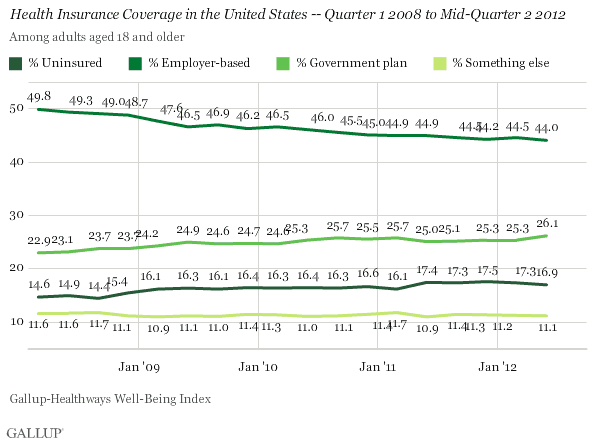WASHINGTON, D.C. -- The percentage of 18- to 25-year-old Americans who do not have health insurance fell from 24.5% in the first quarter of 2012 to 23% so far in the second quarter -- reinforcing the general downward trend that began after the healthcare law provision allowing adults up to age 26 to remain on their parents' plans took effect in September 2010.

The uninsured rate for 18- to 25-year-olds first began to decline in the fourth quarter of 2010 after the provision went into effect, dropping to 26.3% from 28.0% in the third quarter of 2010. It then declined further to 24% in the first quarter of 2011 and plateaued at about that level until falling slightly during the current quarter. Gallup will continue to monitor the uninsured rate among young adults to see if it continues to drop, or if it will level off once again. Gallup will publish full second quarter 2012 results in July.
Over the past four years, 26- to 64-year-olds have become more likely to be uninsured, with the percentage lacking coverage now at 19.6% up from 15% in January 2008, when Gallup and Healthways first started tracking Americans' health insurance coverage. There has, however, been little change in the insured rates of 26- to 64-year-olds in 2012.
The percentage of seniors who are uninsured is little changed since 2008, varying between 2.8% and 3.7%, with measures at the low end of that range in recent months. Since seniors qualify for Medicare, very few adults aged 65 and older lack health insurance.
Overall, 16.9% of all U.S. adults are uninsured in the second quarter of 2012 so far, on par with levels recorded over the past year. However, this measure remains up from 2008 through 2010. The increase in the percentage of all Americans who were uninsured in the second quarter of 2011 coincides with Gallup's decision to include more cell phone-only respondents in the U.S. beginning April 1. Thus, some of the increase in the uninsured could reflect the greater representation of cell phone-only respondents -- who tend to be younger -- in Gallup samples.
Fewer adults report getting their health insurance through an employer, with 44.0% saying this in the second quarter of 2012, down from the high of 49.8% in January 2008. The current percentage of Americans with employer-based health insurance is the lowest Gallup has recorded.
The percentage who report that they get their health coverage through Medicare, Medicaid, or military/veterans' benefits has increased over time -- and is now at 26.1%, the highest Gallup has recorded.

The percentage of Americans who say they get their health insurance through "something else" -- which could mean they purchase it themselves -- has hovered around 11% since tracking began in 2008.
Bottom Line
The U.S. Supreme Court is set to announce its ruling by the end of the month on the constitutionality of the 2010 healthcare law. The court could rule in several different ways -- it may uphold the entire healthcare law, or it may strike all -- or just parts -- of it down as unconstitutional. If the court should decide to strike down the entire law, the young adults who appear to have taken advantage of the provision allowing them to stay on their parents' health insurance until age 26 may lose their coverage. Thus, these young adults will be even more reliant on an upturn in the economy for access to health insurance.
While young adults seem to have increased their access to coverage since the law was passed in 2010, those aged 26 to 64 have become less likely to have health insurance. And, more broadly, the uninsured rate among all Americans remains higher since 2008, with fewer receiving coverage from an employer, and more Americans getting care from a government program.
About the Gallup-Healthways Well-Being Index
The Gallup-Healthways Well-Being Index tracks well-being in the U.S., U.K., and Germany and provides best-in-class solutions for a healthier world. To learn more, please visit well-beingindex.com.
Survey Methods
Results are based on telephone interviews conducted as part of the Gallup-Healthways Well-Being Index survey April 1-May 31, 2012, with a random sample of 57,645 adults, aged 18 and older, living in all 50 U.S. states and the District of Columbia, selected using random-digit-dial sampling.
For results based on the total sample of national adults, one can say with 95% confidence that the maximum margin of sampling error is ±1 percentage point. For results based on national adults aged 18 to 25, one can say with 95% confidence that the maximum margin of sampling error is ±2 percentage points.
Interviews are conducted with respondents on landline telephones and cellular phones, with interviews conducted in Spanish for respondents who are primarily Spanish-speaking. Each sample includes a minimum quota of 400 cell phone respondents and 600 landline respondents per 1,000 national adults, with additional minimum quotas among landline respondents by region. Landline telephone numbers are chosen at random among listed telephone numbers. Cell phone numbers are selected using random-digit-dial methods. Landline respondents are chosen at random within each household on the basis of which member had the most recent birthday.
Samples are weighted by gender, age, race, Hispanic ethnicity, education, region, adults in the household, and phone status (cell phone only/landline only/both, cell phone mostly, and having an unlisted landline number). Demographic weighting targets are based on the March 2011 Current Population Survey figures for the aged 18 and older non-institutionalized population living in U.S. telephone households. All reported margins of sampling error include the computed design effects for weighting and sample design.
In addition to sampling error, question wording and practical difficulties in conducting surveys can introduce error or bias into the findings of public opinion polls.
For more details on Gallup's polling methodology, visit www.gallup.com.In addition to sampling error, question wording and practical difficulties in conducting surveys can introduce error or bias into the findings of public opinion polls.
[Polls conducted entirely in one day, such as this one, are subject to additional error or bias not found in polls conducted over several days.]
For more details on Gallup's polling methodology, visit https://www.gallup.com/.
